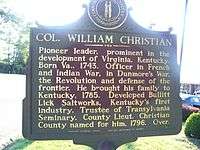William Christian (Virginia)
William Christian (c.1743 – April 9, 1786) was an Indian fighter, Continental soldier, militiaman and politician from the Colony of Virginia who served in the era of the American Revolution. The Town of Christiansburg, Virginia, is named in his honor. He was a signatory to the Fincastle Resolutions and founder of Fort William (now Louisville, Kentucky). Christian helped to negotiate the Treaty of Long Island—making peace between the Overmountain Men and the majority of the Cherokee tribes in 1777.
Early life
Christian was born in Staunton, Virginia, a descendant of a Manx family which had previously migrated to Ireland. His parents, Israel Christian and Elizabeth Starke, had settled in Virginia in 1740, where they ran a general store.
Personal and civic life
In the mid-1760s, Christian worked in the law office of Patrick Henry, and married Henry's sister, Anne. Christian resided in Botetourt County, Virginia and then Fincastle County, Virginia. He represented Fincastle County in the Virginia House of Burgesses for three sessions, from 1773 to 1775. He was a signatory to the Fincastle Resolutions, the earliest statement of armed resistance to the British Crown in the American Colonies.
In 1775, with the approach of the American Revolutionary War, Christian served on the Fincastle Committee of Safety, and attended the March 20 and July 17 meetings of the Virginia Conventions.
The Town of "Christiansburgh," Virginia – as it was originally spelled – was named in honor of Christian, who was an early settler in the region. Originally a concentration of taverns and rest stops along the Great Wilderness Road (present-day U.S. Route 11), the original 1.1-square mile Town was established on November 10, 1792, by an act passed by the Virginia General Assembly. The Town of Christiansburg was later incorporated on January 7, 1833.
Military duty
At about the age of 18, William served as a captain in the Anglo-Cherokee War under Colonel William Byrd. In 1774, he commanded a regiment of militia from Fincastle County in Dunmore's War, but he and his troops arrived too late to participate in the decisive Battle of Point Pleasant.
On February 13, 1776, he was appointed lieutenant colonel of the 1st Virginia Regiment of the Continental Army, and was promoted to colonel in March. When the British-allied Cherokees under Dragging Canoe and Oconostota went to war with the colonies in 1776, Christian resigned his commission in July of that year, accepting a commission as colonel in the militia from the Virginia Council of Defense.
Christian led an expedition against the Overhill Cherokees, which saw little action but compelled some of the chiefs to agree to peace. He served in the commission which negotiated the "Treaty of the Long Island of the Holston" with the Cherokees, signed on July 20, 1777. He was also a commissioner in a second treaty with the Cherokees – in 1781.
Fort William


William Christian and his wife helped established Fort William, Kentucky, where he directed the defense of what is now Louisville from Native American attacks.[1]
Post-revolution
In 1785, Christian moved his family to the neighborhood of the Louisville settlement, where he executed claims to 9,000 acres (36 km²) of land. He was killed in the Illinois Country (in the area which is now southern Indiana) the next year during battle with the Wabash Indians. Christian is buried in Jefferson County, Kentucky in the Bullitt cemetery in Oxmoor, near his residence, a log house still standing.
Legacy
Several places are named after him:
- Christiansburg, Virginia
- Christian County, Illinois
- Christian County, Kentucky[2]
- Christian County, Missouri
Notes
- Perrin, William Henry (1884). Counties of Christian and Trigg, Kentucky : historical and biographical. F.A. Battey Publishing Company. pp. 48–49.
- McCormick, Thomas Denton. "William Christian" in the Dictionary of American Biography, vol. III, p. 96, edited by Dumas Malone. New York: Scribner's, 1936; revised 1964.
References
- ↑ Kentucky Historical Marker Number 974, Kentucky Historical Society, Jefferson County Kentucky at Eight Mile House
- ↑ The Register of the Kentucky State Historical Society, Volume 1. Kentucky State Historical Society. 1903. p. 34.
External links
- Historical marker in Jefferson County, Kentucky
- Historical marker in Hopkinsville, Kentucky, noting that Christian County was named for him in 1797.
- Find-A-Grave profile for William Christian,